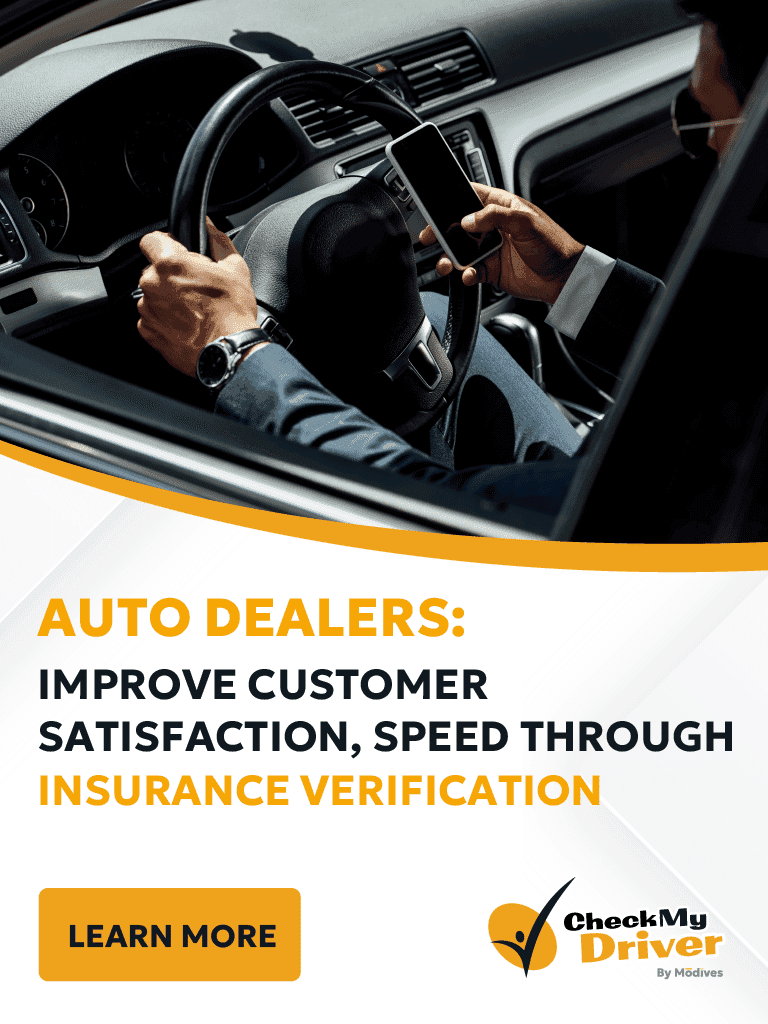In a country as car dependent as the US, auto insurance is essential to the safety and financial health of drivers everywhere. The rise in uninsured drivers on the road hikes up insurance rates and poses a risk to themselves and others. That’s why it’s so important to accurately verify and monitor their coverage to make sure it comes in handy when the unexpected happens.
But auto insurance verification is a complex subject, and it’s evolving quickly thanks to new technology. Let’s talk about the ins and outs of auto insurance verification, including what it is, how it’s changed over time, and how dealerships and lenders can upgrade their processes in a modern landscape.
Table of Contents
What Is Auto Insurance Verification?
Insurance verification for auto dealerships is the process of checking a driver’s auto insurance to ensure that it’s both active and adequate. In the auto sales industry, this process is typically conducted during a sale or rental, but risk-conscious dealerships may also introduce it before a test drive or short-term loaner.
💡 Did you know?
Some state governments run their own programs in order to enforce auto insurance laws. In these jurisdictions, insurance carriers are required to provide periodic updates on their customers’ status to the state database. If there’s a lapse in coverage, the DMV will contact the driver before suspending their vehicle registration.
Why Dealerships Verify Insurance
Insurance verification has come to be an established practice in the car sales process, mainly due to laws that require all vehicle owners to carry minimum coverage to be on the road. Although most states won’t hold the seller responsible for checking it off, it’s understood as a standard across car dealerships.
However, for dealerships who deal with leasing and financing, this step is absolutely essential. And for these businesses, minimum liability insurance isn’t nearly enough to protect their interests. Oftentimes, they’ll impose insurance requirements above state minimums, including comprehensive and collision coverage. Some may even require gap insurance to cover the difference between the car’s value and the lease balance in case of a total loss.
Without an airtight process to verify and monitor insurance, there’s no way to ensure that customers comply with these requirements. Particularly for BHPH dealerships that service low credit customers, there’s a major risk that a customer opts out of getting the required insurance coverage.
Then, if anything happens while they’re on the road, they’ll have to pay it out of pocket. If they can’t afford vehicle repairs, it may end up falling on the dealership, likely after repossession. With the average collision claim totaling $5,992, verifying insurance saves your business from incurring major costs over time.
The Evolution of Auto Insurance Verification
The traditional process of auto insurance verification has a long history, and it hasn’t changed much until recently.
Traditional auto insurance verification
The standard across most dealerships primarily relies on manual methods, starting with dealership staff asking the customer to provide a physical insurance card or declaration page. Then, they call the insurance company to confirm that information or request an insurance binder with details about the driver’s current auto insurance policy. From there, they review the documents against their requirements to make sure that the coverage is adequate.
When it comes to leasing and financing, dealerships typically monitor insurance after the sale by getting added as “additional interest” to every customer’s insurance policy. This designation means that if the customer cancels their policy, you’ll receive a notification from the insurance provider. However, between the time it takes to process the update and mail out the letter, you may not find out until 60 days after the cancellation.
Industry trends driving change
For all of the downsides of the current insurance verification process, it’s managed to persist for decades. However, dealerships are gradually starting to move away from manual methods, mainly due to some key trends.
Compliance regulations
Effective June 9, 2023, the Federal Trade Commission enacted amendments to the FTC Safeguards Rule to enforce the security of customer information. This update categorized many auto dealerships as “financial institutions,” thereby holding them to stricter standards with regards to consumer privacy.
A major focus in this plan is the handling of personal identifiable information (PII). PII refers to any information that directly identifies an individual or which can be used to identify an individual in conjunction with other data, such as name, home address, or phone number.
The traditional insurance verification process is filled with opportunities for violations, from dealership staff taking photos of ID cards to F&I managers accidentally leaving customer information in the office fax machine. With the penalty recently raised to $51,744 per violation, each mistake can be very costly.
Rising fraud cases
Recent years have seen a significant rise in fraud. Leading the charge in this trend is synthetic fraud, a form of identity theft in which criminals create fake identities by combining real and fabricated information. This can result in major losses for dealerships In fact, experts estimate that synthetic fraud alone accounts for $7.9 billion in loss exposure for the auto industry.
Insurance verification provides an additional check after ID validation to help dealerships weed out fraudsters. Given how critical this step is, many dealerships are finding that it’s no longer worth risking the opportunity for error by using manual processes.
Call center and mail delays
It’s no secret that the coronavirus pandemic had a major impact on the business world. During this time, increased demand, labor shortages, and logistics challenges resulted in increased delays across call centers and postal services.
Unfortunately, many of these issues have continued to persist even years after restrictions were lifted. Because traditional insurance verification relies on receiving letters and making calls to insurance agents, these delays can significantly hold up the process. That’s why some dealerships are turning to methods that eliminate manual steps altogether.
Modern insurance verification
In recent times, emerging insurance tech has made it possible for dealerships to move away from manual processes and automate their insurance verification flow. With new software, they can replace steps like collecting proof of insurance and calling insurance carriers, instead pulling data directly from the source.
For the customer, this means that they no longer need to run to their car to retrieve documents, or wait for the F&I manager to make a phone call to verify the information. For the dealership, this means their staff spends less time on hold, and there’s less sensitive information floating around their fax machines to risk an FTC violation.
Some solutions even bridge the gap further by automatically reviewing the documents and comparing them against the dealership’s requirements. CheckMy Driver, for instance, runs the customer’s data through an AI-powered engine to return usable results in seconds. In the end, the customer and office receive an easy-to-read report on whether the policy information is active, accurate, and adequate.

3 Steps to Automating Auto Insurance Verification at Your Dealership
In the evolving insurance landscape, it’s time to figure out how new technology can help you achieve your business goals. It all starts with finding the right solution and helping your team leverage it to improve your efficiency and customer experience.
1. Find an insurance verification solution
The first step to automating your insurance verification process is finding the right solution for you. As previously discussed, there are different options available depending on the level of automation you’re looking for. While some applications simply retrieve the customer’s insurance documents, others will conduct analysis on top of that to streamline the entire process.
Based on the level of insurance expertise across your team and your bandwidth for manual work, you need to figure out which type is best for you.
2. Implement change management
Once you’re set up with an insurance verification solution, it’s time to conduct training.To start, you’ll need to help your on-the-ground team through the transition by providing resources on the new workflow. While automation increases efficiency over time, there’s often a small upfront cost to learning a new way to do things.
You’ll also need to think about how to ensure smooth customer adoption. Consumers can sometimes be nervous about new software, especially when it comes to sharing personal information. That’s why it’s important to set up the process so it’s easy to understand.
For instance, dealerships that use CheckMy Driver receive a placard with a QR code that customers can scan when it comes time to verify insurance. That takes them to a link where they can provide secure access to their insurance information by logging into their provider website. Because this process is customer-initiated, consumers tend to feel more confident in their data privacy.
3. Set up ongoing monitoring
For dealerships that provide leasing or financing services, insurance monitoring is one of the most critical steps to streamline. Due to the delayed notice and manual work involved in additional interest, the value of automating this process is high.
Solutions like CheckMy Driver can automatically pull real-time information directly from the provider on a regular basis, notifying your team if there’s a lapse in coverage. That way, you can quickly take action by placing collateral protection insurance (CPI) to bridge the gap.
Not only does this new technology provide enhanced protection over your asset, but it does so without creating any more work for your team.
How to Get Started
Ready to join the new wave of insurance verification? Talk with our team or read up on how CheckMy Driver can help your dealership save time and win new business.

